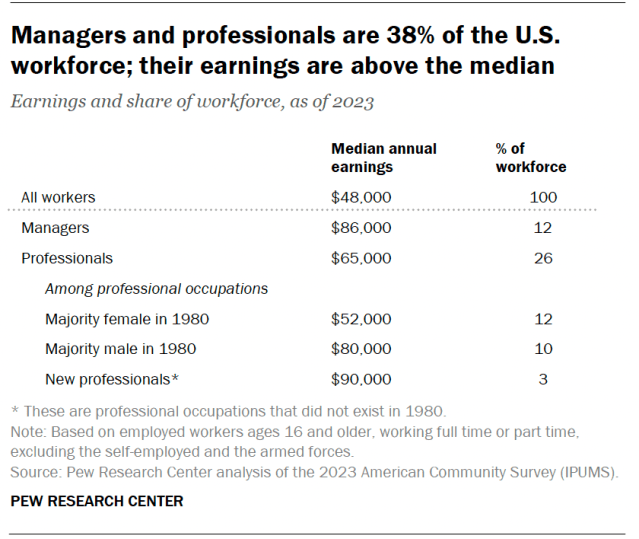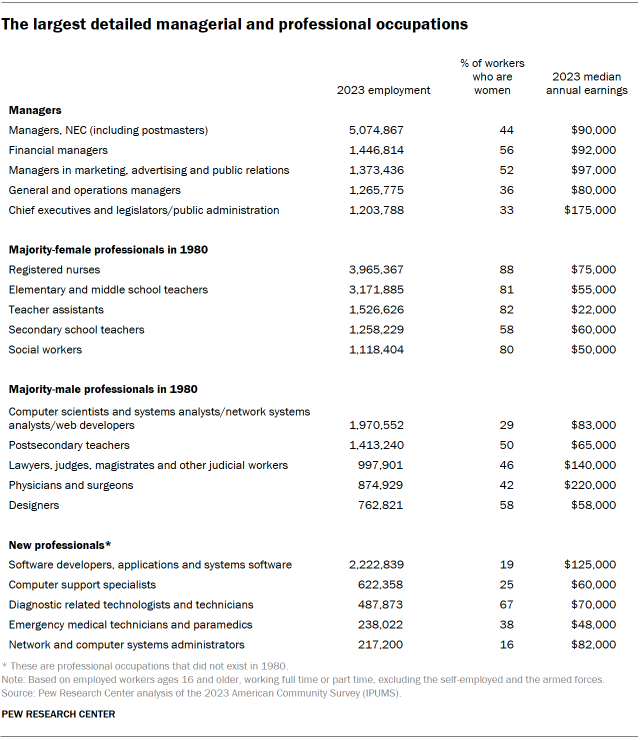
Women hold a rising share of high-paying occupations in the United States. They are also a growing share of managers and professionals, according to a Pew Research Center analysis of federal data.

In 2023, 46% of all managers in the U.S. were women. This is up from 29% in 1980 but still slightly lower than the 49% of all workers who were women as of 2023.
Managers are defined as workers in one of 21 detailed management occupations (refer to “How we did this” for how these are classified in occupational data).
Women were 58% of workers in professional and related occupations in 2023, up from 52% in 1980. The professional occupation group includes 109 detailed occupations ranging from computer and mathematical jobs, to social service occupations, to health care practitioners.

Managers and professionals tend to earn more than the typical U.S. worker.
In 2023, the median manager earned $86,000 annually, and workers in professional and related occupations earned a median $65,000. This compares with $48,000 for workers across all occupations.
Today, nearly 56 million workers are managers or professionals, and they make up 38% of the workforce, up from 23% in 1980.
Women’s presence in male- and female-dominated professional occupations
Some professional occupations were made up mainly of women in 1980, but more were majority male. Women’s presence across these occupations today is uneven.
- Women continue to make up a large share of the 28 professional occupations where women were the majority of workers in 1980. In 2023, 80% of workers in these jobs were women, up from 77% in 1980. Some examples of majority-female occupations include registered nurses, teachers and social workers.
Overall, these majority-female professional jobs don’t pay as well as other professional occupations. In 2023, workers in majority-female professional jobs earned $52,000 at the median. By comparison, workers in majority-male professional occupations earned $80,000.
- Women have made inroads among the 61 professional occupations where men were the majority of workers in 1980. Women are now filling 38% of majority-male professional jobs, up from 23% in 1980. Some examples of these occupations include computer scientists, physicians, lawyers and judges.
- Some professional occupations today did not exist in 1980. Examples include software developers, EMTs and network administrators. These occupations tend to be high paying. The median new professional earned $90,000 in 2023. However, women make up a relatively small share of this group – 33% in 2023.
As far as specific managerial occupations, women make up anywhere from 12% of construction managers to 74% of medical and health service managers as of 2023. Unlike professional occupations, almost no managerial occupations were majority female in 1980.
Why women have made gains
A majority of managerial and professional workers have at least a bachelor’s degree. Women have been outpacing men in college completion for decades, and they now make up the majority of college-educated workers – 53% in 2023, up from 39% in 1980.
Another factor is the growing importance of social skills in managerial and professional jobs. Employees increasingly work in teams, and managers increasingly need social skills to succeed. Studies have found that women have an edge over men in jobs in which social skills are more important. Analyses of job skills in the U.S. often use O*NET, the U.S. Department of Labor’s survey of workers, employers, and experts that ranks detailed job tasks in many occupations. Social skills, or people skills, include tasks such as negotiation, persuasion, communication skills, leadership and social perceptiveness.
Related publications:

